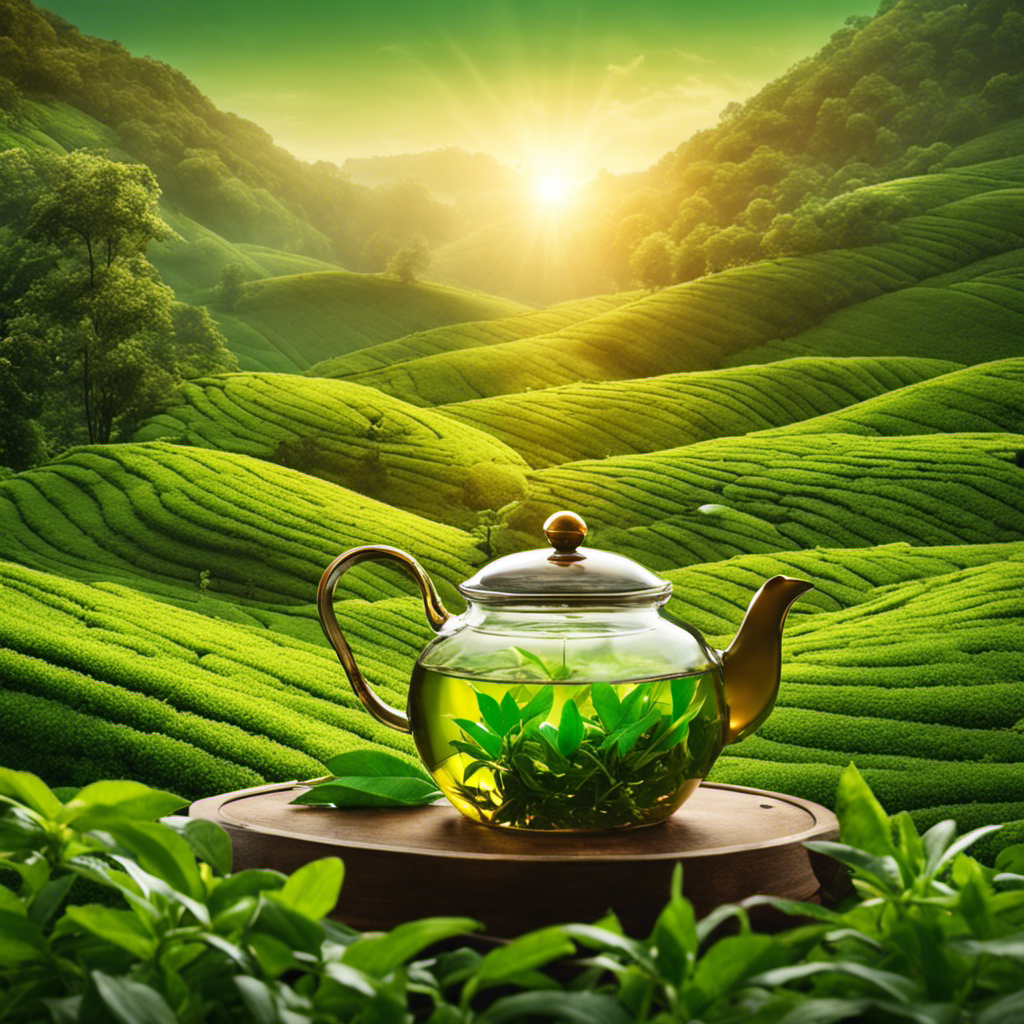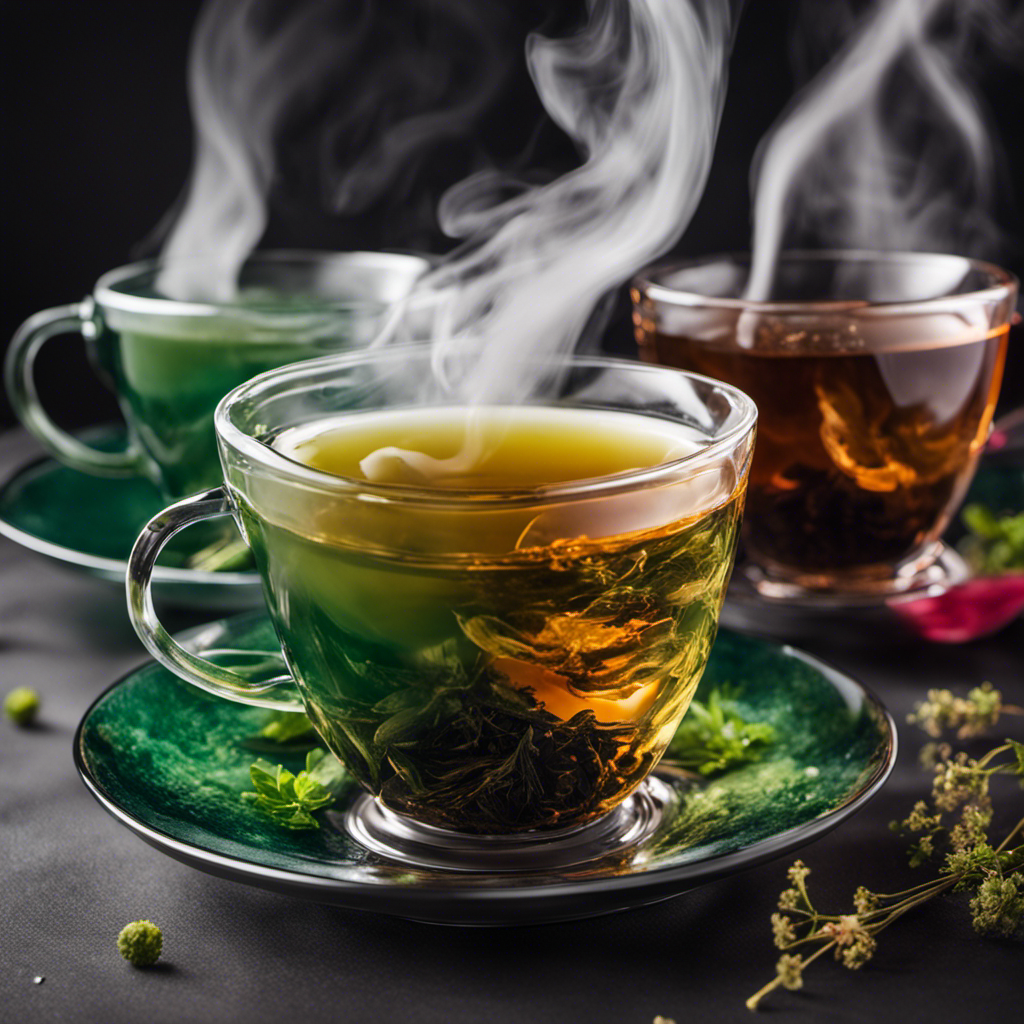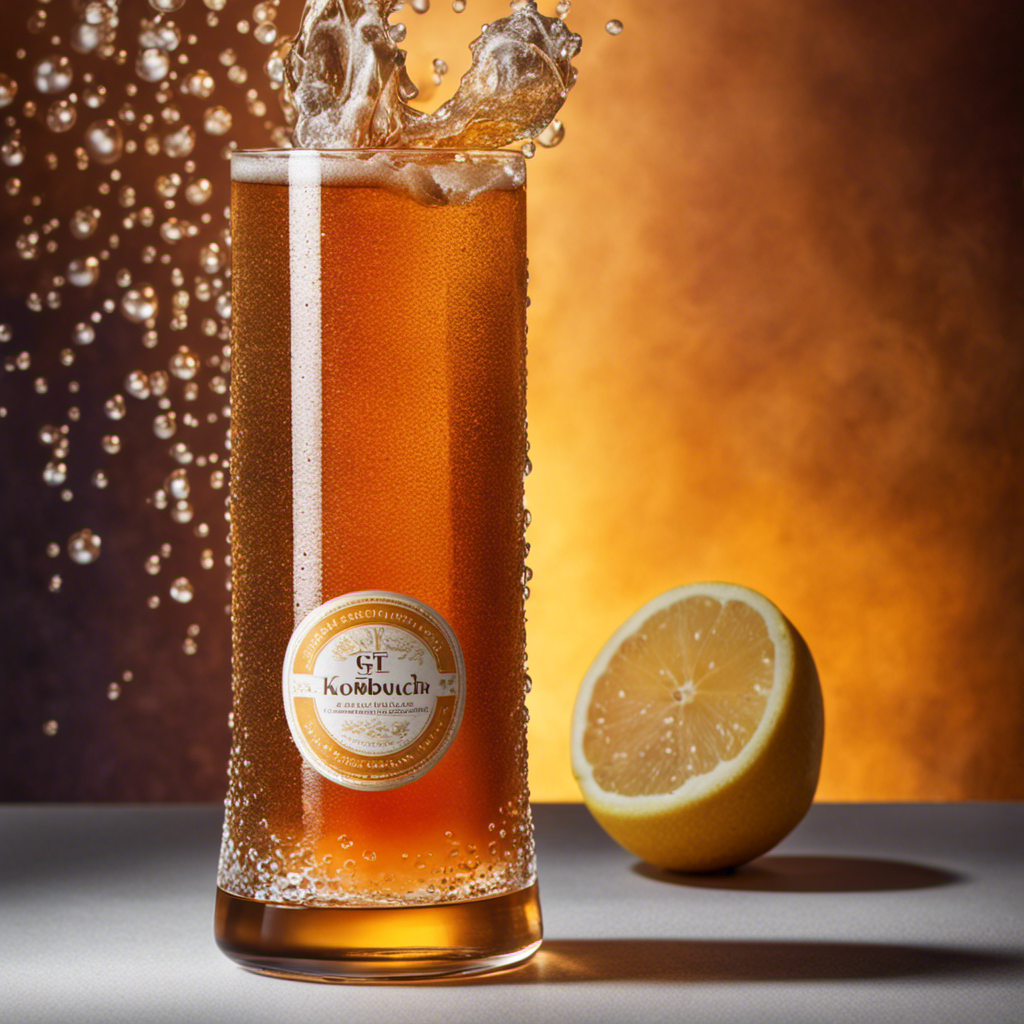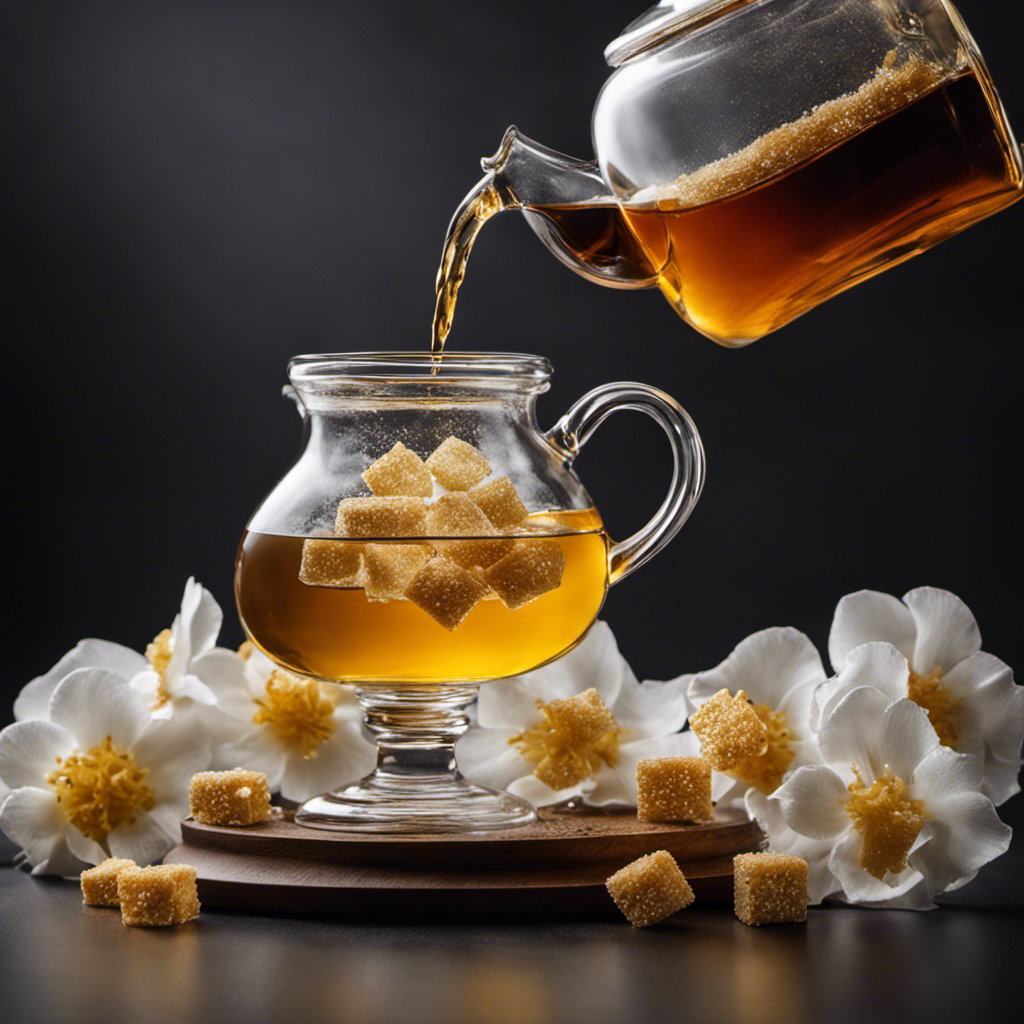Matcha
Beginner’s Guide to Cooking With Green Tea Powder

Welcome to our beginner’s guide to cooking with green tea powder! We know what you might be thinking – green tea powder sounds intimidating and complicated. But fear not! We’re here to show you just how easy and rewarding it can be to incorporate this versatile ingredient into your culinary creations.
With its vibrant color and unique flavor, green tea powder, also known as matcha, adds a delightful twist to a wide range of dishes. Whether you’re a seasoned chef or just starting out in the kitchen, this guide will equip you with the knowledge and techniques you need to master the art of cooking with green tea powder.
Get ready to discover a whole new world of delicious possibilities!
Key Takeaways
- Green tea powder, also known as matcha, is rich in antioxidants which can help prevent aging and various diseases.
- There are different grades of green tea powder, including ceremonial grade matcha and culinary grade matcha, each with their own flavor profiles and culinary uses.
- Bamboo whisk, fine-mesh sifter, mortar and pestle, ceramic matcha bowl, and measuring spoon are essential kitchen tools for cooking with green tea powder.
- Green tea powder pairs well with citrus fruits, berries, and nuts, and can be incorporated into various recipes to add a unique and earthy flavor.
Health Benefits of Green Tea Powder
One of the most notable health benefits of green tea powder is its ability to boost our overall well-being through its powerful antioxidants and anti-inflammatory properties.

Green tea powder, also known as matcha, is made from finely ground tea leaves and contains higher levels of antioxidants than regular brewed green tea. These antioxidants help to protect our cells from damage caused by harmful free radicals, which can contribute to aging and various diseases.
Additionally, the anti-inflammatory properties of green tea powder can help to reduce inflammation in the body, which is linked to chronic diseases such as heart disease and diabetes.
Incorporating matcha into our daily routine is easy and delicious. We can start by adding a teaspoon of green tea powder to our morning smoothie or mixing it into our favorite yogurt.
For a refreshing drink, we can make a matcha latte by whisking green tea powder with hot water and frothy milk. There are also countless green tea powder recipes available online, from matcha pancakes to matcha ice cream.
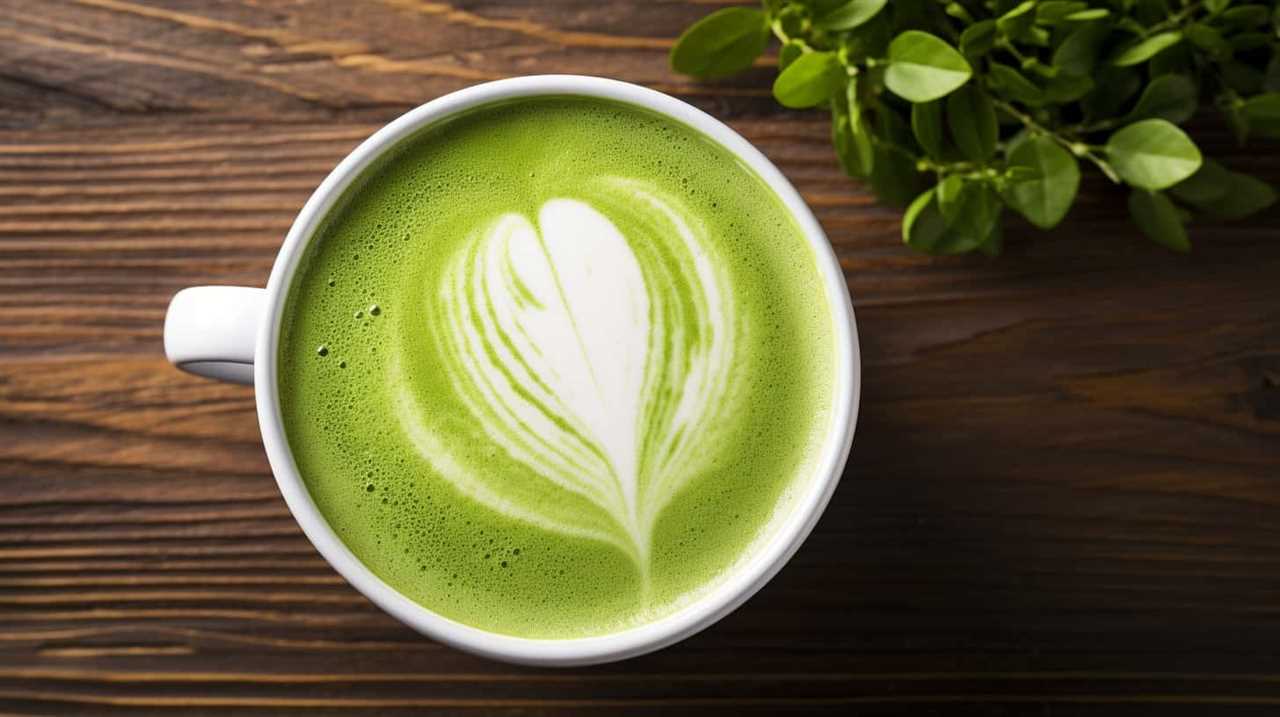
Types of Green Tea Powder
To understand the different types of green tea powder, let’s explore the various variations and origins of this versatile ingredient.
Green tea powder, also known as matcha, comes in different grades that determine its quality and flavor profile. The highest grade, ceremonial grade matcha, is made from young tea leaves that are carefully hand-picked and stone-ground into a fine powder. It has a vibrant green color and a smooth, delicate taste.
Culinary grade matcha, on the other hand, is more affordable and has a slightly bitter and earthy flavor, making it ideal for baking and cooking.
There are also flavored green tea powders, such as matcha with added jasmine or hojicha, which offer unique taste experiences.

When choosing your green tea powder, consider the grade and the intended culinary uses to ensure the best results in your cooking adventures.
Choosing the Right Green Tea Powder
When it comes to choosing the right green tea powder for cooking, there are a few important factors to consider.
One of the main distinctions is between matcha and sencha. Matcha is a powdered green tea that’s often used in traditional tea ceremonies, while sencha is a loose-leaf tea that’s more commonly consumed.
Additionally, you’ll want to decide whether you need culinary-grade or ceremonial-grade powder, depending on the intensity of flavor you desire for your recipes.

Matcha Vs. Sencha
As novice cooks, we often find ourselves faced with the decision of which green tea powder to use in our recipes, and it can be quite confusing to choose between matcha and sencha. To help you make an informed choice, here are the key differences and similarities in taste and aroma between matcha and sencha:
- Matcha:
- Taste: Matcha has a rich, umami flavor with a slightly bitter undertone. It’s smooth and creamy on the palate.
- Aroma: Matcha has a vibrant and grassy aroma that’s both refreshing and invigorating.
- Sencha:
- Taste: Sencha has a more delicate and vegetal taste compared to matcha. It has a mellow sweetness with a hint of grassiness.
- Aroma: Sencha has a fresh and fragrant aroma, reminiscent of freshly cut grass.
When choosing the best green tea powder for different recipes, consider the flavor profile you desire. Matcha works well in desserts and creamy dishes, while sencha is great for lighter dishes and beverages. Experiment and find what suits your taste preferences best!
Culinary or Ceremonial Grade?
What factors should we consider when choosing between culinary and ceremonial grade green tea powder?
When deciding whether to use culinary or ceremonial grade green tea powder, it’s important to consider the intended purpose and application.
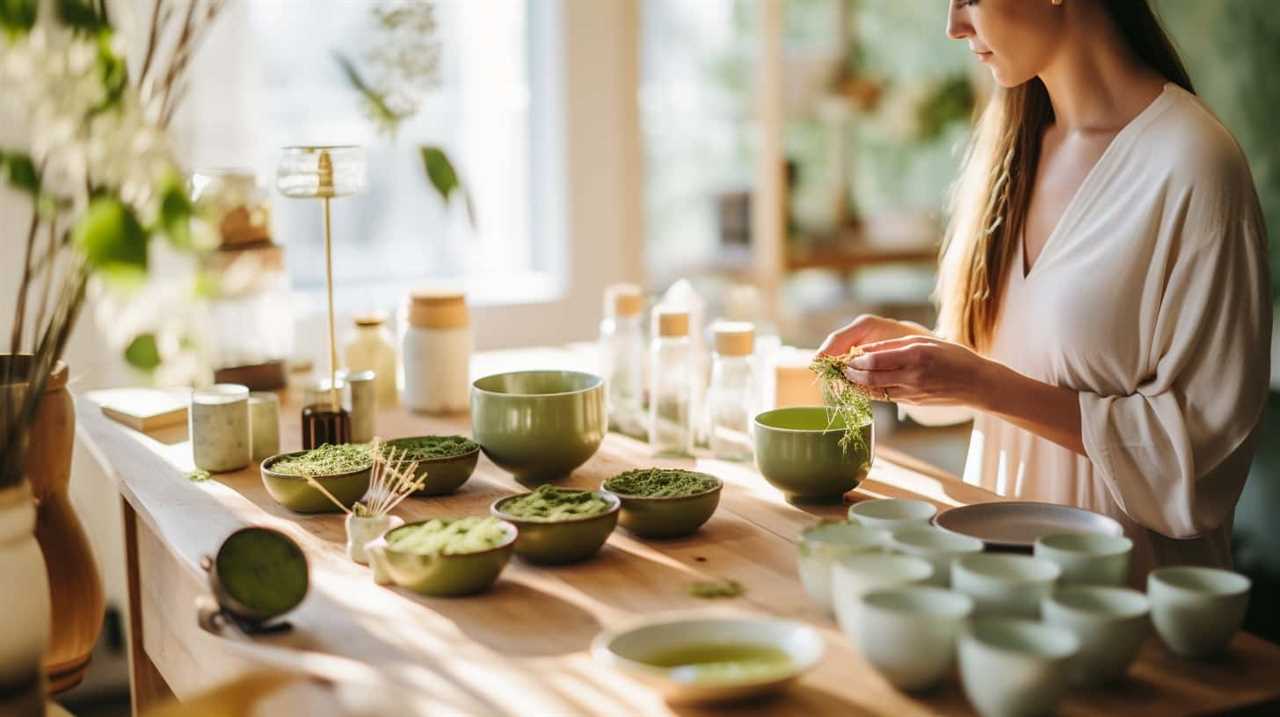
Culinary grade green tea powder, also known as matcha, is commonly used in cooking and baking. It has a slightly bitter and grassy flavor, making it perfect for adding a unique twist to recipes like smoothies, desserts, and even savory dishes.
On the other hand, ceremonial grade green tea powder is traditionally used in tea ceremonies and is known for its vibrant green color and delicate flavor. It’s usually prepared by whisking the powder with hot water to create a frothy and fragrant beverage.
While both grades of green tea powder can be enjoyed for their health benefits, culinary grade is more versatile for modern applications, while ceremonial grade is better suited for traditional tea ceremonies.
Essential Kitchen Tools for Cooking With Green Tea Powder
We rely on a few essential kitchen tools to make the most out of cooking with green tea powder. These tools not only enhance our cooking techniques but also help us achieve the perfect balance of flavors and textures. Here are the essential kitchen tools you’ll need:

- Whisk: A bamboo whisk, or chasen, is crucial for preparing matcha tea. Its delicate bristles help create a smooth and frothy texture, ensuring a rich and flavorful cup of tea.
- Sifter: Green tea powder can sometimes have clumps, so using a fine-mesh sifter is essential to break them up and achieve a smooth consistency.
- Mortar and Pestle: Grinding your own green tea leaves into powder can be a rewarding experience. A mortar and pestle allows you to do this with precision, preserving the tea’s aroma and flavor.
- Measuring Spoon: Accurate measurement of green tea powder is important for maintaining consistency in your recipes. A dedicated measuring spoon ensures you add the right amount every time.
With these essential tools at your disposal, you’ll be ready to explore the wonderful world of cooking with green tea powder.
Basic Techniques for Using Green Tea Powder in Recipes
Now let’s talk about the basic techniques for using green tea powder in recipes.
Green tea powder, also known as matcha, has flavor enhancing properties that can elevate the taste of various dishes. Not only does it add a unique and vibrant flavor, but it also offers numerous health benefits, such as being rich in antioxidants and promoting relaxation.
Flavor Enhancing Properties
To unlock the full potential of green tea powder in recipes, one must harness its flavor enhancing properties. This versatile ingredient can elevate the taste of a variety of dishes when used correctly. Here are some essential techniques for utilizing green tea powder’s flavor enhancing abilities:
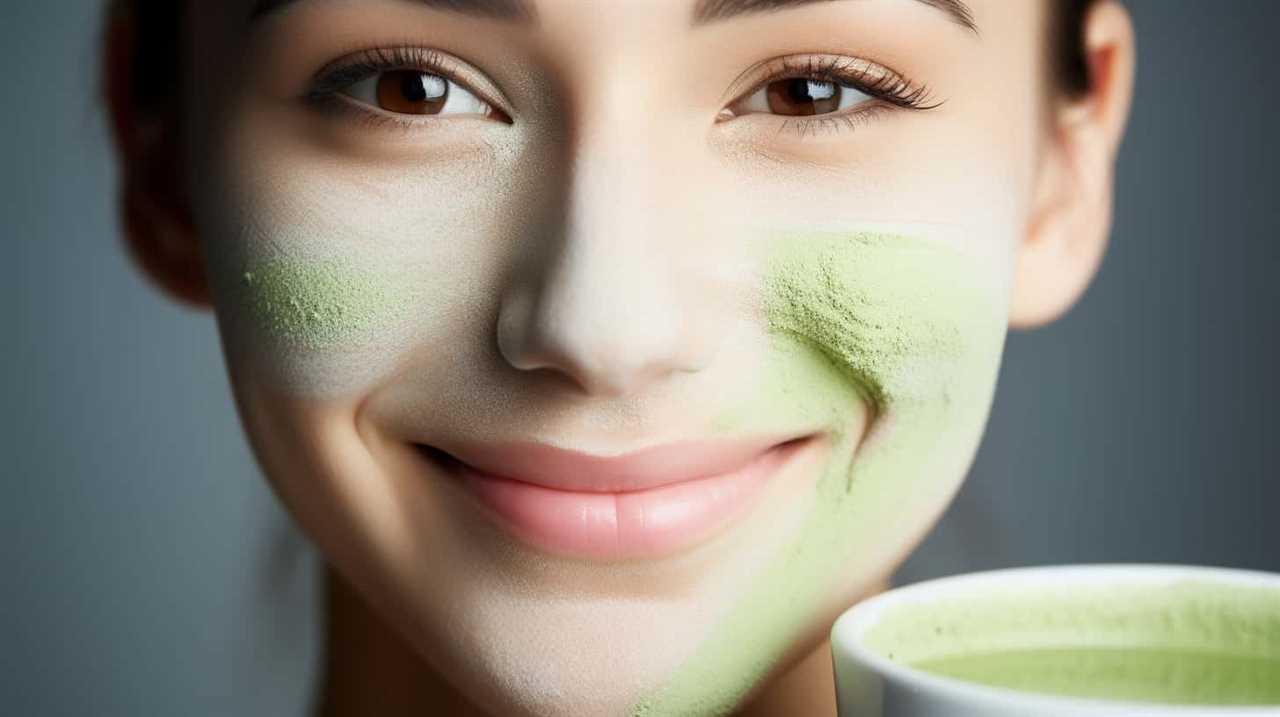
- Flavor Pairing: Experiment with different ingredients to find the perfect flavor combinations. Green tea powder pairs well with citrus fruits, berries, and nuts, adding a unique depth and complexity to your dishes.
- Citrus Fruits: The tanginess of lemons or oranges complements the earthy notes of green tea powder, creating a vibrant and refreshing flavor profile.
- Berries: The natural sweetness of berries balances out the slight bitterness of green tea powder, resulting in a harmonious blend of flavors.
- Cooking Techniques: Incorporate green tea powder into your recipes using various cooking methods to maximize its flavor potential.
- Infusing: Steep green tea powder in hot water or milk to extract its flavor and create an aromatic base for beverages, desserts, or sauces.
- Dusting: Sprinkle a light layer of green tea powder on top of baked goods, such as cakes or cookies, to add a subtle yet distinct flavor.
Health Benefits of Matcha
One important aspect to consider when cooking with green tea powder is the numerous health benefits that matcha offers. Matcha is a type of green tea that’s ground into a fine powder, making it more potent and concentrated than regular green tea leaves. This vibrant green powder is packed with antioxidants, which help to protect the body against free radicals and reduce the risk of chronic diseases. Matcha also contains caffeine, which provides a gentle energy boost without the jitters commonly associated with coffee. Additionally, matcha is known to promote relaxation and mental clarity due to its high content of L-theanine, an amino acid that has a calming effect on the mind.
Incorporating matcha into your diet can be as simple as adding it to smoothies or lattes, providing you with a delicious and nutritious way to enjoy its benefits.
Speaking of delicious, let’s now explore some matcha-infused breakfast ideas.
Delicious Matcha-infused Breakfast Ideas
Let’s explore some mouthwatering breakfast ideas that incorporate the vibrant flavors of matcha green tea powder.
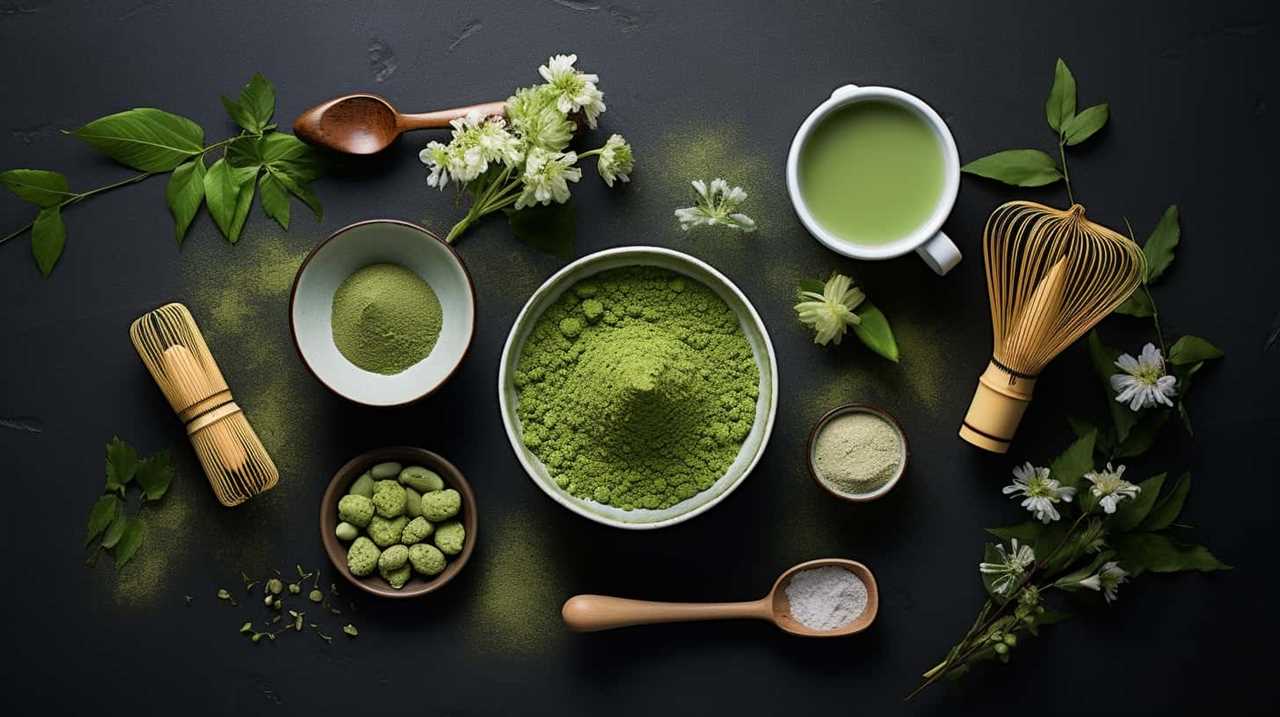
Matcha smoothie bowls are a refreshing and nutritious way to start your day. Simply blend frozen bananas, almond milk, a scoop of matcha powder, and your favorite toppings like granola and fresh berries. It’s a creamy and energizing breakfast that will leave you feeling satisfied.
Another delicious option is green tea pancakes. These fluffy pancakes are made by adding matcha powder to your pancake batter. The result is a stack of pancakes with a beautiful green hue and a subtle earthy flavor. Top them off with maple syrup or a dollop of Greek yogurt for a delightful morning treat.
These matcha-infused breakfast ideas aren’t only delicious but also a great way to reap the many health benefits of green tea.
Creative Ways to Incorporate Green Tea Powder in Desserts
Now, let’s delve into the creative ways we can incorporate the vibrant flavors of green tea powder into our delectable desserts.
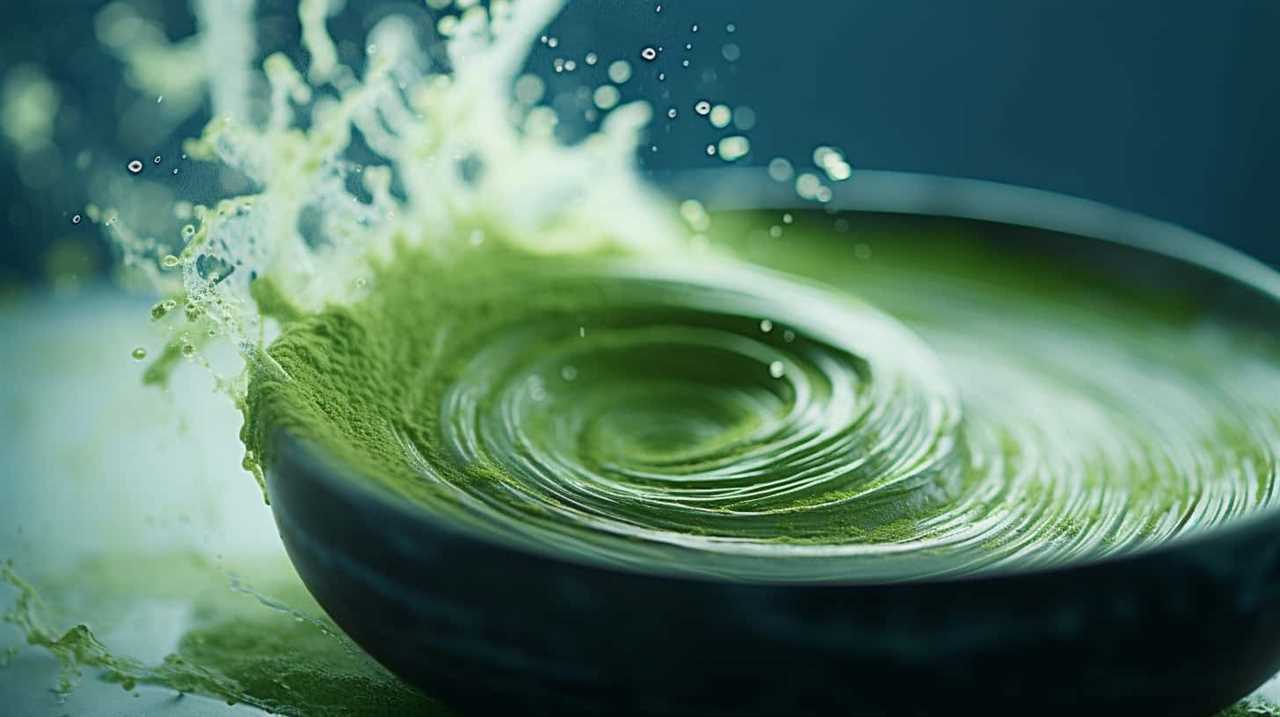
Green tea powder, also known as matcha, adds a unique and earthy flavor to sweet treats. One creative presentation idea is to make green tea-infused ice cream. Simply mix green tea powder into your favorite ice cream base and freeze it for a refreshing and indulgent treat.
Another delicious option is to make green tea-flavored macarons. The combination of the delicate almond cookies and the subtle bitterness of the green tea powder creates a perfect balance of flavors.
For a more unconventional dessert, try making green tea-flavored cheesecake. The creamy texture of the cheesecake pairs beautifully with the herbal notes of the green tea powder.
Green Tea Powder in Savory Dishes: Surprising Recipes to Try
To continue exploring the versatility of green tea powder, we can now delve into surprising recipes where it adds a unique and flavorful twist to savory dishes. Incorporating green tea powder into savory recipes may seem unconventional, but it can elevate your dishes to a whole new level.

Here are some unique uses for green tea powder in savory green tea recipes:
- Marinating: Create a fragrant and tenderizing marinade by combining green tea powder with soy sauce, ginger, garlic, and a touch of honey. This marinade works wonders on chicken, tofu, or even vegetables.
- Seasoning: Sprinkle green tea powder on roasted vegetables, grilled meats, or popcorn for an unexpected burst of flavor. Its earthy and slightly bitter taste adds depth to any dish.
- Dressings and Sauces: Blend green tea powder into creamy dressings or tangy sauces for a vibrant and refreshing twist. It pairs particularly well with sesame oil, rice vinegar, and a hint of citrus.
Experiment with these surprising savory recipes and discover the unique and delicious ways green tea powder can enhance your culinary creations.
Frequently Asked Questions
Can Green Tea Powder Be Used as a Substitute for Regular Tea Leaves?
Yes, green tea powder can be used as a substitute for regular tea leaves. It offers various benefits, such as a stronger flavor and higher concentration of antioxidants. It’s a versatile ingredient for cooking and can be used in various recipes.
Is It Safe to Consume Green Tea Powder During Pregnancy?
During pregnancy, it is generally safe to consume green tea powder in moderation. However, it’s important to consult with a healthcare professional for recommended dosage. The benefits of green tea powder include antioxidant properties and potential support for overall wellness.

Are There Any Side Effects of Consuming Green Tea Powder?
When consuming green tea powder, it is important to be aware of potential interactions with certain medications and its impact on liver function. These factors can have side effects that should be considered.
How Should Green Tea Powder Be Stored to Maintain Its Freshness?
To maintain the freshness of green tea powder, store it in an airtight container in a cool, dark place. This will help preserve its flavor and aroma. Additionally, green tea powder can be used in smoothies and desserts, offering a range of health benefits.
Can Green Tea Powder Be Used in Skincare Products?
Yes, green tea powder can be used in skincare products. Incorporating green tea powder in face masks can provide numerous benefits for the skin, such as antioxidant protection, reducing inflammation, and promoting a healthy complexion.
Conclusion
In conclusion, exploring the world of cooking with green tea powder can lead to a plethora of possibilities.
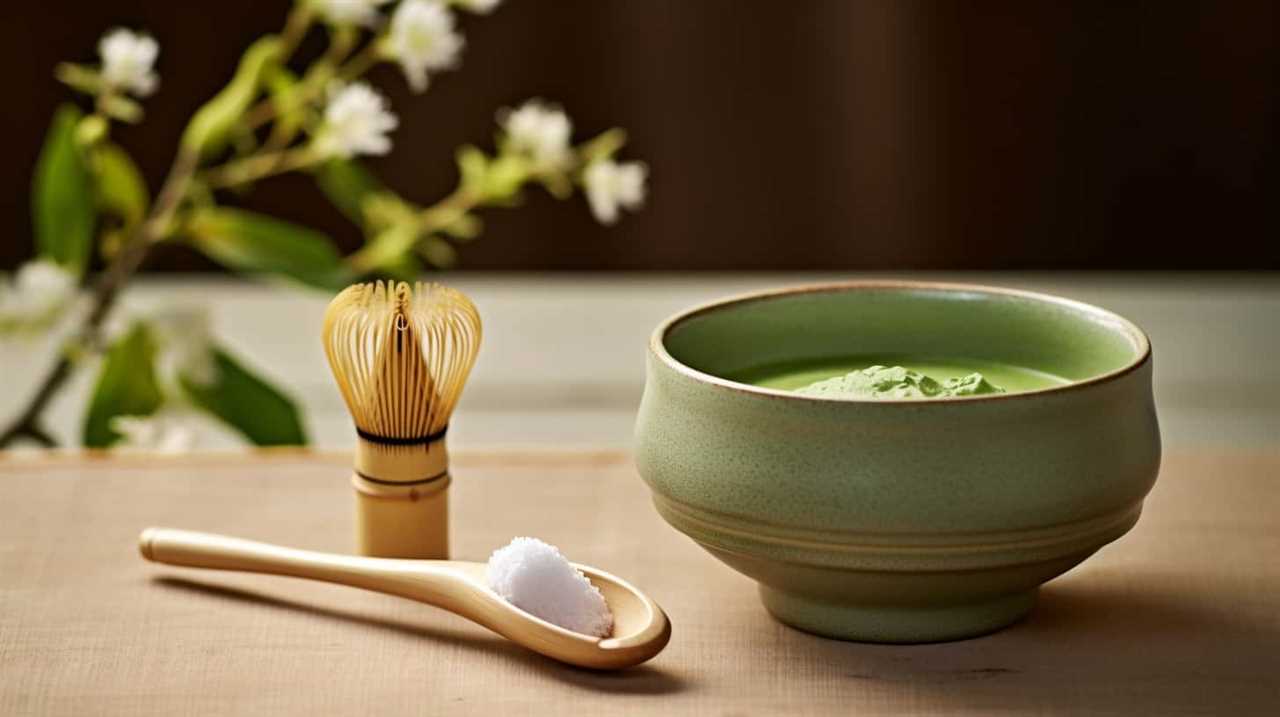
From its numerous health benefits to its versatile uses in both sweet and savory dishes, this vibrant ingredient adds a touch of zest and zen to your culinary creations.
So why wait? Grab your green tea powder and get ready to embark on a flavorful and fascinating journey that will leave your taste buds tantalized and your dishes transformed.
Justin is a seasoned author, coffee and tea enthusiast, and an essential member of the Cappuccino Oracle team. With a keen appreciation for the complexities of coffee, coffee alternatives, and tea, Justin has dedicated his professional career to exploring these realms and sharing his insights with readers worldwide.
Justin’s immersion in the world of coffee, coffee alternatives, and tea began at a young age, kindling a passion that extended beyond mere consumption. This love for these beverages led him to combine his talent for writing with his devotion to coffee and tea, bringing him to Cappuccino Oracle as a dedicated author.
Matcha
Unveiling The Mysteries Of Matcha: Insights On Its Origins, Production, And Quality

Have you ever been curious about the mysteries behind the rich and natural flavors of matcha? If so, get ready to join me on an adventure as we uncover the secrets of matcha, delving into its origins, production, and quality.
As a lover of all things tea, I have delved deep into the world of matcha, immersing myself in its rich history and intricate production process. From the shade-grown tea leaves to the meticulous grinding technique, every step is a labor of love that culminates in the velvety smooth powder we know as matcha.
Join me as we unravel the secrets behind this ancient Japanese tradition and discover why quality is key when indulging in this verdant elixir. We’ll explore the nuances of flavor, the importance of sourcing, and even delve into the fascinating world of other tea varieties.
So grab a cup, sit back, and let’s dive into the captivating world of matcha.
Key Takeaways
- Matcha tea is made from powdered green tea leaves and has a long and labor-intensive production process.
- Premium matcha is made from the first harvest in early spring, using the top 3 sprouts of the tea plant and ground tencha leaves.
- Cheaper matchas may skip some steps in the production process and are more suitable for matcha lattes.
- High-quality matcha is recommended for sparing consumption, as it has a smoother flavor and more health benefits compared to cheaper matchas.
What is matcha?
I’ve learned that matcha is a powdered green tea made from special tea leaves that are shaded before harvest, and it has a long and labor-intensive production process.
There are different types of matcha available, but the premium matcha is made from the first harvest in early spring, using only the top 3 sprouts of the tea plant. The leaves are then steamed, dried, and have their stems removed before being ground into a fine powder using a specialized mill made of granite.
It’s important to note that high-quality matcha is recommended for sparing consumption, as it has a complex production process that results in a smooth flavor. Matcha also offers various health benefits, such as being rich in antioxidants, boosting metabolism, and improving mental alertness.
Production process
The matcha production process involves shading the tea leaves before harvest and selecting the top three sprouts of the tea plant for premium matcha. Shading is a technique used to enhance the flavor and quality of the tea leaves. By covering the tea plants with shade, the leaves produce more chlorophyll and amino acids, resulting in a vibrant green color and a rich, umami taste.
After the shading period, only the top three sprouts of the tea plant are carefully handpicked for premium matcha. These selected leaves, known as tencha leaves, are then steamed, dried, and have their stems removed.
Finally, the tencha leaves are ground into a fine powder using a specialized granite mill. This process results in the smooth and concentrated matcha powder that we enjoy.
Quality and consumption
Let me tell you, indulging in high-quality matcha is like sipping a vibrant green elixir that awakens your taste buds and nourishes your body with its rich flavor and numerous health benefits. Matcha’s health benefits are truly remarkable. Packed with antioxidants, vitamins, and minerals, matcha is known to boost metabolism, enhance focus and concentration, and strengthen the immune system.
But not all matcha is created equal. Different grades of matcha exist, ranging from ceremonial grade to culinary grade. Ceremonial grade matcha is made from the highest quality tencha leaves and has a smooth, vibrant green color and a delicate, umami flavor. It is best enjoyed on its own, whisked with hot water.
On the other hand, culinary grade matcha is more affordable and is suitable for making matcha lattes, smoothies, and baked goods. Although it may have a slightly bitter taste and a duller color, it still provides health benefits.
So, whether you choose to indulge in high-quality ceremonial grade matcha or opt for the more affordable culinary grade, incorporating matcha into your routine is a delicious way to reap its health benefits.
Frequently Asked Questions
What are some popular ways to enjoy matcha besides drinking it as tea?
Besides drinking matcha as tea, some popular ways to enjoy it include indulging in matcha desserts like matcha ice cream, matcha cake, and matcha cookies. Additionally, matcha smoothies are a refreshing and healthy option.
Are there any specific health benefits associated with consuming matcha?
I’m no expert, but matcha is said to have potential health benefits. Some claim it can aid in weight loss due to its high antioxidant content and metabolism-boosting properties. However, more research is needed to confirm these claims.
How does the quality of matcha affect its flavor and overall experience?
The quality of matcha directly affects its flavor and overall experience. Higher quality matcha, made from carefully selected leaves and processed with precision, offers a smoother and more vibrant flavor, while lower quality matcha may have a less appealing taste and color.
Can matcha be used in cooking or baking?
"Where there’s matcha, there’s a way! Matcha can be used in a variety of cooking and baking recipes, adding a vibrant green color and a unique earthy flavor to dishes like matcha desserts."
Are there any specific tips or techniques for properly preparing matcha tea at home?
To properly prepare matcha tea at home, start by sifting the matcha powder to remove any clumps. Then, choose water at around 175°F to 180°F for the best flavor. Gradually add water to the matcha and whisk in a "W" or "M" motion until frothy. Enjoy!
Conclusion
In conclusion, matcha tea is not just a beverage, but a rich and fascinating tradition that has evolved over centuries.
From its origins in Japan to its intricate production process, matcha is a labor of love.
The quality of matcha is crucial, as the steps taken in its production directly impact its flavor and aroma.
Whether you’re a matcha connoisseur or a beginner, there is a matcha tea out there for you.
So, why not indulge in a cup of this vibrant green elixir and experience the magic of matcha for yourself? It’s a journey worth embarking on!
Arf, an author and an innovative enthusiast of coffee, coffee alternatives, and tea, plays a crucial role as a contributor to the esteemed Cappuccino Oracle platform. Renowned for his curiosity and passion for these captivating beverages, Arf has carved out a unique space for himself in the world of exploration and writing. He realized that coffee, coffee alternatives, and tea are not mere drinks to keep one awake, but universes of flavors and stories waiting to be explored.
Arf’s articles for Cappuccino Oracle blend meticulous research with personal experiences, providing readers with an in-depth understanding of various types of coffee, coffee alternatives, and tea, along with their unique characteristics, cultures, and histories. His honest reviews and engaging narratives guide readers on their own journeys, helping them discover their preferences and find their perfect brew.
Matcha
Unveiling The Truth Behind Starbucks’ Matcha: A Disappointing Blend

Being a lover of tea, I was eager to sample Starbucks’ matcha beverages, anticipating a flavorful and genuine taste. However, to my dismay, I found that it was a subpar mixture of inexpensive green tea powder and an excessive amount of sugar. This was a stark contrast to the customary matcha experience that I had grown accustomed to.
The use of low-quality matcha by Starbucks is driven by the need for mass production and a consistent taste across all locations. But in this pursuit, they have sacrificed the true essence of matcha. Authentic matcha production involves meticulous steps to ensure a high-quality and flavorful product, steps that Starbucks seems to skip.
The result is a matcha latte packed with 32 grams of sugar, equivalent to a can of soda, and a whopping 240 calories. It’s time to unveil the truth behind Starbucks’ matcha and explore better options for a truly satisfying tea experience.
Key Takeaways
- Starbucks uses a cheap green tea powder for their matcha drinks, which may not even be considered matcha.
- The cheap matcha powder is mixed with a lot of sugar, negating the health benefits and undermining the quality of the tea.
- Starbucks’ matcha latte contains a high amount of sugar, similar to a can of soda, and has a significant number of calories.
- To have a better matcha experience, it is recommended to explore premium, first harvest matcha made by talented farmers in Japan and to try different matcha options to find preferred taste.
What is Starbucks Matcha?
Starbucks Matcha is a cheap green tea powder mixed with a high amount of sugar, which not only undermines the health benefits of matcha but also fails to deliver the natural, great-tasting flavor of authentic matcha tea.
The ingredients used in Starbucks matcha include low-quality green tea powder that is likely produced on a large scale. Unlike traditional matcha production methods, Starbucks skips certain steps to save time and money. These steps, such as shading the tea plants to reduce bitterness and selecting the top leaves for their flavor and nutrients, are crucial in creating high-quality matcha.
Instead, Starbucks opts for a blend of cheap green tea powder mixed with sugar, resulting in a dull and bitter flavor. This disappointing blend of ingredients does not live up to the standards of true matcha tea.
Quality vs. Cheap Matcha
Indulging in high-quality matcha is like savoring a delicate melody that dances on your taste buds, while settling for cheap matcha is akin to a discordant symphony that leaves a bitter aftertaste. When it comes to matcha, quality matters. Traditional matcha production is an art that requires time, patience, and attention to detail. The importance of shading the tea plants, selecting the top leaves, and using a stone mill to grind the leaves into a fine powder cannot be overstated. These steps not only enhance the flavor but also preserve the health benefits of matcha. High-quality matcha is rich in antioxidants, boosts metabolism, and promotes a sense of calm. On the other hand, cheap matcha often lacks these qualities as it skips crucial steps and is mixed with sugar and other additives. Don’t settle for a subpar matcha experience; choose high-quality matcha for its exceptional taste and health benefits.
| Traditional Matcha Production |
|---|
| Shading the tea plants |
| Selecting the top leaves |
| Grinding with a stone mill |
The importance of traditional matcha production cannot be overstated. These steps not only enhance the flavor but also preserve the health benefits of matcha. High-quality matcha is rich in antioxidants, boosts metabolism, and promotes a sense of calm. On the other hand, cheap matcha often lacks these qualities as it skips crucial steps and is mixed with sugar and other additives. Don’t settle for a subpar matcha experience; choose high-quality matcha for its exceptional taste and health benefits.
Recommendations for Better Matcha
Exploring different matcha options can lead to a better matcha experience. When it comes to matcha, not all options are created equal. While Starbucks may offer a convenient matcha latte, there are alternative options that provide a more authentic and higher quality experience.
Premium matcha, specifically first harvest matcha, is made by talented farmers in Japan and can be enjoyed plain, without the need for excessive sugar or additives. By choosing premium matcha, you can reap the full benefits that matcha has to offer, such as its high antioxidant content and potential health benefits.
Additionally, exploring different types of matcha, such as Japanese black tea, can expand your taste palate and introduce you to new and exciting flavors. So, why settle for a disappointing blend when there are better matcha options out there waiting to be explored?
Frequently Asked Questions
How is Starbucks matcha different from traditional matcha?
Starbucks matcha differs from traditional matcha in terms of quality and taste. One interesting statistic is that Starbucks’ matcha latte contains 32 grams of sugar, similar to a can of soda, which undermines the health benefits of matcha.
What are the health benefits of matcha and how do they differ between Starbucks matcha and premium matcha?
The health benefits of matcha include high levels of antioxidants, increased energy, and improved focus. However, Starbucks matcha quality is compromised due to the use of cheap powder mixed with sugar, negating these benefits.
Can you customize the sweetness level of Starbucks matcha drinks?
Yes, you can customize the sweetness level of Starbucks matcha drinks. They offer popular matcha drink variations like matcha latte and matcha frappuccino, allowing customers to choose the amount of sweetener they prefer.
Are there any alternative options for matcha drinks at Starbucks?
Yes, there are alternative options for matcha drinks at Starbucks. However, it’s important to note that the taste may not be comparable to traditional matcha. Exploring different matcha options and Japanese black tea can provide a better experience.
What are the steps involved in producing high-quality matcha and how does Starbucks’ matcha production differ?
Starbucks’ matcha production process differs from traditional matcha production in Japan. High-quality matcha involves shading the tea plants, selecting the top leaves, steaming, drying, and grinding them. However, Starbucks skips these steps, resulting in a lower quality and less authentic matcha experience.
Conclusion
In conclusion, after delving into the truth behind Starbucks’ matcha, it’s clear that their blend falls short of expectations. The use of cheap green tea powder mixed with excessive sugar dilutes any potential health benefits and fails to deliver an authentic matcha experience.
To truly enjoy the rich and flavorful taste of matcha, it’s recommended to explore premium, first harvest options crafted by skilled Japanese farmers. Don’t settle for subpar matcha; treat yourself to a tea experience that’ll leave your taste buds dancing with delight.
Arf, an author and an innovative enthusiast of coffee, coffee alternatives, and tea, plays a crucial role as a contributor to the esteemed Cappuccino Oracle platform. Renowned for his curiosity and passion for these captivating beverages, Arf has carved out a unique space for himself in the world of exploration and writing. He realized that coffee, coffee alternatives, and tea are not mere drinks to keep one awake, but universes of flavors and stories waiting to be explored.
Arf’s articles for Cappuccino Oracle blend meticulous research with personal experiences, providing readers with an in-depth understanding of various types of coffee, coffee alternatives, and tea, along with their unique characteristics, cultures, and histories. His honest reviews and engaging narratives guide readers on their own journeys, helping them discover their preferences and find their perfect brew.
Matcha
The Ultimate Guide To Using Chashaku: Your Matcha Essential

Being a lover of matcha, I am aware that the crucial factor in achieving the perfect matcha bowl is the equipment we utilize. When it comes to preparing matcha, there is one tool that is particularly essential: the chashaku.
This bamboo spoon, with its elegant design and precise measurements, is the secret weapon of matcha lovers worldwide. In this ultimate guide, I will take you on a journey through the history and evolution of the chashaku, and show you how to use it like a pro.
From its origins as a metal or ivory scoop to its modern-day incarnation in bamboo, the chashaku has come a long way. With its 48° bend and 18mm length, it effortlessly scoops the perfect amount of matcha from its container.
So grab your chashaku and get ready to elevate your matcha game to new heights. Let’s dive in and discover the wonders of this matcha essential.
Key Takeaways
- Chashaku is a bamboo spoon used to scoop matcha powder in the Japanese tea ceremony and by matcha lovers worldwide.
- Chashaku is one of the three important tea utensils used in the tea ceremony and is about 18mm in length with a 48° bend at the end for scooping.
- Chashaku is made of bamboo to avoid negative reactions with matcha powder and is a great measurement tool for matcha powder.
- Two scoops of chashaku is the standard amount for a bowl of matcha tea, and it is easy to maneuver in matcha tins or natsume due to its small size.
What is Chashaku?
Chashaku is a bamboo spoon used to scoop matcha powder, and it’s one of the three important tea utensils used in the Japanese tea ceremony.
Made from a single piece of bamboo, this elegant tool has a long history dating back to the Muromachi period in Japan. Originally crafted from metal or ivory, chashaku evolved to be made of bamboo due to its natural properties and to avoid any negative reactions with matcha powder.
The design of chashaku is both functional and beautiful, with a length of about 18mm and a 48° bend at the end for easy scooping. There are different styles of chashaku scoops, each with its own unique shape and characteristics. The back of the chashaku has a rough texture, while the face is smooth and sleek.
Whether you’re a matcha lover or a tea ceremony enthusiast, using a chashaku adds a touch of authenticity and tradition to your matcha preparation.
History and Evolution
During the Muromachi period in Japan, the chashaku spoon evolved from being made of metal or ivory to its current bamboo form, which is about 18mm in length and has a 48° bend at the end for easier scooping. The history and evolution of the chashaku is a testament to its significance in Japanese tea ceremonies and its cultural importance in matcha preparation.
| The significance of chashaku in Japanese tea ceremonies | The cultural importance of chashaku in matcha preparation |
|---|---|
| Chashaku is one of the three important tea utensils used in the tea ceremony. | Chashaku is a great measurement tool for matcha powder. |
| Chashaku originated in Japan during the Muromachi period. | Chashaku’s small size allows for easy maneuvering in matcha tins or natsume. |
| Originally made of metal or ivory, chashaku evolved to be made of bamboo. | Chashaku is made from a single piece of bamboo and shaped with a bend for the scoop. |
| Chashaku is made of bamboo to avoid negative reactions with matcha powder. | The back of chashaku has a rough texture, while the face is smooth and sleek. |
The chashaku’s role in Japanese tea ceremonies cannot be understated. It is one of the three essential utensils used in the tea ceremony, alongside the chawan (tea bowl) and chasen (tea whisk). The chashaku’s small size and precise measurement make it the perfect tool for scooping matcha powder. Its evolution from metal or ivory to bamboo shows the cultural importance placed on this utensil. The chashaku’s design, with its gentle bend and smooth face, allows for easy and graceful scooping of matcha. Using the chashaku is not only practical but also a way to honor the centuries-old tradition of matcha preparation.
How to Use Chashaku
To use the chashaku, I simply hold it like a pencil and dip the scoop into the matcha container. Then, I carefully lift the chashaku scoop out and place it over the matcha bowl to dump the powder.
It’s a simple and elegant technique that ensures the perfect amount of matcha every time.
But did you know that there are alternative ways to use the chashaku? Some matcha lovers prefer to use a teaspoon or a regular spoon to scoop their matcha powder. While these alternatives may work in a pinch, they don’t offer the same precision and authenticity as the chashaku.
The chashaku’s unique design and size make it the ideal tool for measuring matcha powder. Plus, using the chashaku adds a traditional touch to the matcha preparation process, enhancing the overall experience.
So why settle for anything less? Embrace the chashaku and elevate your matcha game to the next level.
Frequently Asked Questions
What are the different types of materials used to make chashaku besides bamboo?
There’s something truly magical about the chashaku, the bamboo spoon that gracefully scoops matcha powder. While bamboo is the traditional material, chashaku can also be made from metal or ivory, although these alternatives are less common.
Can chashaku be used to scoop other powders besides matcha?
Yes, chashaku can be used to scoop other powders besides matcha. However, it is primarily designed for scooping matcha powder and is most commonly used in Japanese tea ceremonies. To properly clean and care for a chashaku, it is recommended to wipe it with a dry towel or tissue to avoid water damage. The chashaku is a versatile tool with different uses in the tea ceremony, making it an essential item for matcha lovers.
How long does a chashaku typically last before it needs to be replaced?
A chashaku typically lasts for a long time, but the lifespan can vary depending on the material. Bamboo chashaku is the most common and durable option, while metal or ivory may wear down over time. Proper care involves cleaning with a dry towel or tissue to avoid water damage.
Can chashaku be used with different types of matcha bowls or is it specific to a certain style?
Absolutely! Chashaku can be used with various types of matcha bowls, adapting to different styles. Its small size and unique design make it perfect for scooping matcha powder and adding a touch of elegance to your matcha preparation.
Are there any alternative utensils that can be used in place of chashaku for scooping matcha powder?
Yes, there are alternative utensils for scooping matcha powder, such as a teaspoon or a small spoon. However, using a chashaku has its benefits. Its unique design allows for precise measurements and easy maneuvering in matcha tins.
Conclusion
In conclusion, using chashaku isn’t just a practical way to measure and scoop matcha powder, but it’s also an essential tool for embracing the art and tradition of the Japanese tea ceremony.
While some may argue that using a regular spoon can achieve the same result, chashaku offers a unique experience that connects us to centuries of tea culture. Imagine holding the slender bamboo spoon, feeling the weight of tradition in your hand, and delicately scooping the vibrant green matcha powder.
It’s a sensory journey that brings us closer to the beauty and mindfulness of matcha preparation. So, embrace the chashaku, and let it elevate your matcha experience to new heights.
Arf, an author and an innovative enthusiast of coffee, coffee alternatives, and tea, plays a crucial role as a contributor to the esteemed Cappuccino Oracle platform. Renowned for his curiosity and passion for these captivating beverages, Arf has carved out a unique space for himself in the world of exploration and writing. He realized that coffee, coffee alternatives, and tea are not mere drinks to keep one awake, but universes of flavors and stories waiting to be explored.
Arf’s articles for Cappuccino Oracle blend meticulous research with personal experiences, providing readers with an in-depth understanding of various types of coffee, coffee alternatives, and tea, along with their unique characteristics, cultures, and histories. His honest reviews and engaging narratives guide readers on their own journeys, helping them discover their preferences and find their perfect brew.
-

 Americano4 weeks ago
Americano4 weeks agoHow to Make Americano With Moka Pot
-

 Americano2 weeks ago
Americano2 weeks agoHow to Make Korean Iced Americano
-

 Americano4 weeks ago
Americano4 weeks agoHow to Make Iced Americano With Instant Coffee
-

 Americano4 weeks ago
Americano4 weeks agoHow to Make Americano With Bialetti
-

 Americano4 weeks ago
Americano4 weeks agoHow to Make Dutch Bros Americano
-

 Americano6 days ago
Americano6 days agoHow to Make an Iced Americano With Nespresso
-

 Americano2 weeks ago
Americano2 weeks agoHow Many Shots of Espresso for 16 Oz Americano
-

 Americano4 weeks ago
Americano4 weeks agoHow to Make a Hazelnut Americano








